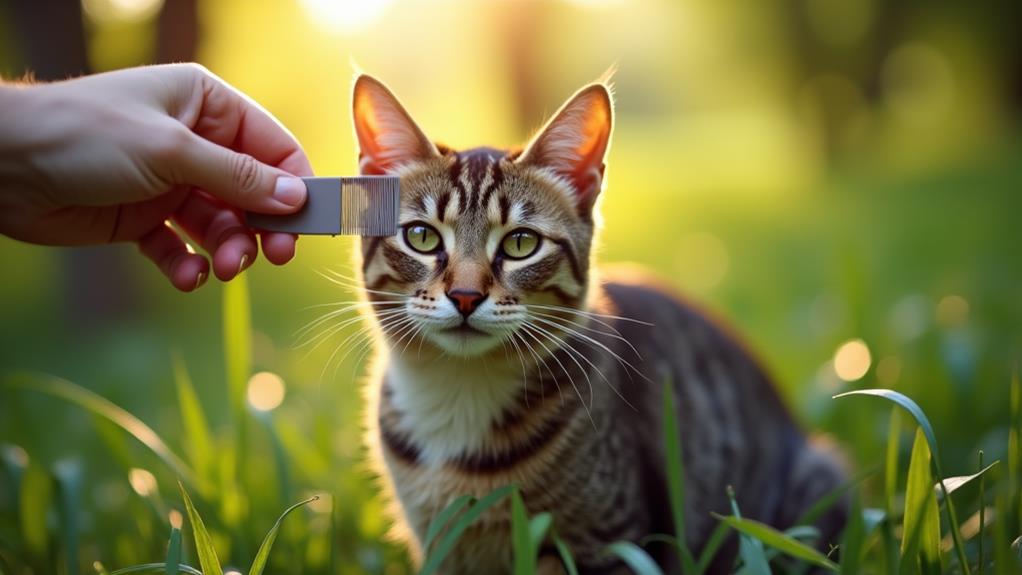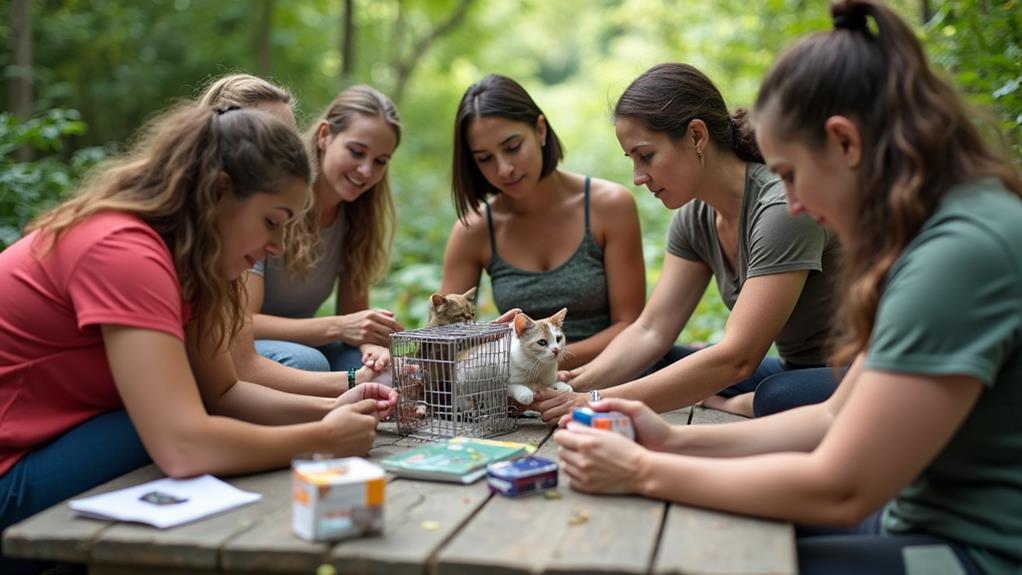How to Deflea a Feral Cat: Safe and Effective Flea Control

To deflea a feral cat safely and effectively, start with immediate relief using Capstar, which kills adult fleas within a day. Then, apply a topical treatment like Advantage or Frontline for ongoing protection, ideally during a spay/neuter procedure for easier handling. Sprinkle diatomaceous earth around their environment to combat fleas naturally. Verify their bedding is regularly cleaned and consider using beneficial nematodes to target flea larvae outdoors. Natural remedies such as brewers yeast and herbs like mint can help deter fleas. Keep observing for any signs of fleas to act swiftly. Uncover more strategies to improve their wellbeing.
Understanding Feral Cat Flea Issues
Feral cats often face significant flea infestations due to their outdoor lifestyles, which can lead to discomfort and health issues like anemia and skin infections. Living outside exposes them to environments where fleas thrive, and these tiny parasites can quickly multiply. A single female flea can produce up to 50 eggs daily, causing infestations to balloon within feral cat colonies. This rapid growth worsens flea-related problems, leading to increased distress for the cats.
You might notice feral cats scratching excessively or losing hair—clear indicators of flea infestations. While healthy feral cats sometimes manage to cope with fleas, heavy infestations often signal underlying health issues such as malnutrition. Malnourished cats struggle more because their bodies can't fight off parasites as effectively. Kittens are especially at risk; severe flea infestations can cause dire health problems if not addressed quickly.
Keeping a close watch on these cats is essential for early intervention. Regular observation helps you spot signs of flea-related health issues before they escalate. Understanding these challenges is the initial step in managing flea infestations in feral cats and ensuring their well-being. Recognizing the problem helps you take action to protect these vulnerable animals.
Safe Flea Treatment Methods
Effectively managing flea infestations in feral cats requires safe and practical treatment methods. One approach is using Capstar, an oral flea treatment. It kills adult fleas within 24 hours and can be mixed with food, making it a straightforward option for feral cats. For long-term flea management, take into account topical treatments like Advantage or Frontline. These are effective but require careful application, which can be challenging with feral cats. Administering them during spay/neuter procedures under anesthesia can simplify the process.
Incorporating natural solutions can also help manage flea populations. Diatomaceous earth is a non-toxic powder that kills fleas on contact. You can safely apply it in areas frequented by feral cats, ensuring it doesn't harm the animals. Another eco-friendly method is using beneficial nematodes. These tiny organisms target flea larvae in shady, moist environments. Remember, reapplication each spring is necessary for peak effectiveness.
Here are three practical steps to bear in mind:
- Use Capstar for immediate flea relief.
- Apply diatomaceous earth in commonly used areas.
- Introduce beneficial nematodes for long-term environmental control.
These methods collectively help in keeping flea infestations under control safely.
Effective Flea Prevention Strategies

While addressing immediate flea infestations is vital, preventing them can save time and resources in the long run. One effective strategy is to regularly administer high-quality flea medicine to feral cats. Options like Capstar provide immediate relief, while topical treatments such as Advantage or Frontline offer long-lasting protection. This guarantees that you're not only treating existing fleas but also preventing future infestations.
Environmental management plays a significant role in your prevention efforts. Regularly clean bedding and areas where feral cats frequent to remove flea eggs and reduce their overall population. This helps in creating an environment that's less hospitable to fleas, making it easier to prevent the fleas from returning. Furthermore, consider using natural flea deterrents like diatomaceous earth and beneficial nematodes. These target flea larvae and are safe for cats, enhancing your environmental management strategy.
Limiting feeding times to no more than 30 minutes can also help. This reduces the likelihood of attracting wildlife that might bring fleas, decreasing the risk of reinfestation. Finally, keep an eye out for signs of fleas, such as excessive scratching or hair loss, to act swiftly and maintain the cats' health.
Natural Remedies for Fleas
When tackling flea infestations naturally, diatomaceous earth is a powerful ally that dehydrates fleas on contact. You can safely apply it in areas where feral cats frequent, but make sure the cats don't ingest it. This natural remedy for fleas acts quickly and is non-toxic to the environment. Another effective option involves using beneficial nematodes, which are microscopic worms targeting flea larvae outdoors. They greatly reduce flea populations and are harmless to cats and other wildlife.
Incorporate these steps into your routine:
- Enhance diet with Brewers yeast: Adding Brewers yeast to a cat's diet may bolster their natural defenses against fleas. This yeast is rich in B vitamins, which can help repel fleas and support general health.
- Herbal repellents: Sprinkle mint or rosemary around resting areas. Fleas dislike strong scents, so these herbs can naturally deter them without chemicals.
- Maintain cleanliness with natural IGRs: Regularly clean cat bedding and living areas. Use natural insect growth regulators like neem oil to disrupt the flea life cycle, preventing reinfestation.
Community Support and TNR Programs

Community support is the backbone of successful Trap-Neuter-Return (TNR) programs, which are fundamental for managing feral cat populations humanely. By involving community members in TNR efforts, you help guarantee that community cats receive the care they need, including spaying/neutering, vaccinations, and ear tipping. These steps are essential in controlling reproduction rates and maintaining the health of feral cat colonies.
TNR programs, now active in over 400 U.S. cities, promote a humane alternative to euthanasia. When you participate in these programs, you're contributing to healthier cat colonies that experience fewer flea infestations. This is because managed colonies with active caretakers offer good nutrition and regular monitoring, leading to improved immune systems and comprehensive cat health.
Local organizations and shelters often work alongside community volunteers like yourself to provide resources and education about TNR. This collaboration improves the effectiveness of flea control efforts. Fundraising for spay/neuter initiatives is also critical, as it sustains the TNR programs that benefit both the cats and the communities they inhabit. By supporting these efforts, you're playing an important role in fostering a healthier environment for community cats and the neighborhoods they call home.




